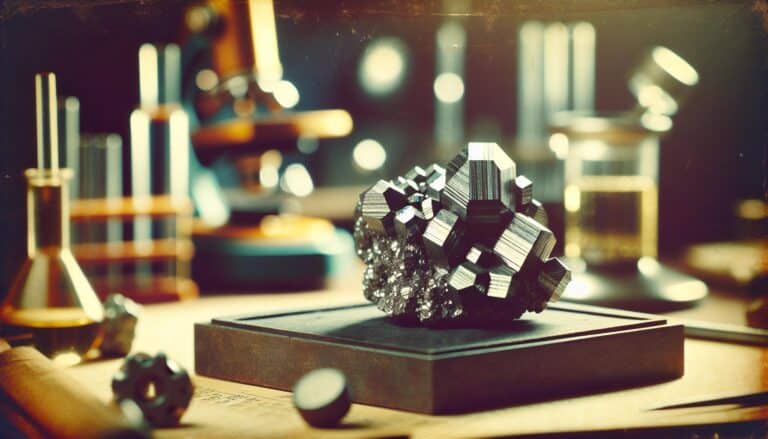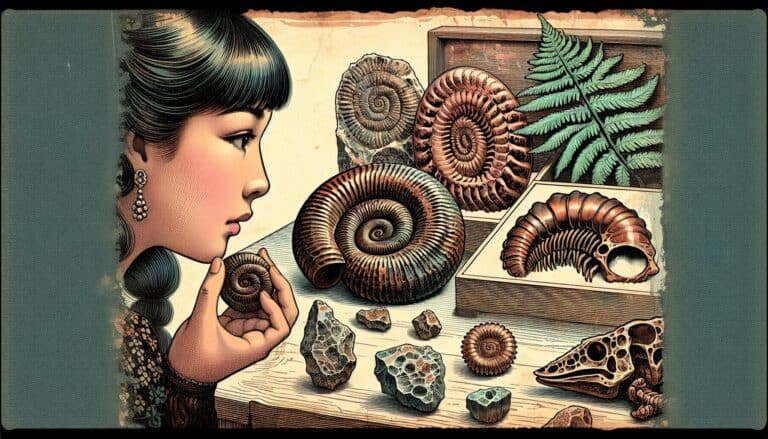You’re on the hunt for apophyllite, the crystal that’s not only a stunner but also a healer.
But how do you distinguish it from other minerals?
It’s easier than you think! With its unique characteristics, apophyllite stands out once you know what to look for.
To identify apophyllite, look for its glassy luster, pyramid-like structures, and a white streak. It’s non-magnetic, ranks 4.5-5 on the Mohs scale, and shows double refraction. Apophyllite’s specific gravity ranges from 2.3 to 2.4, aiding in distinguishing it from other minerals.
How to Identify Apophyllite Through Testing
When you’re set on identifying apophyllite, a series of simple tests can reveal its unique properties. Let’s walk through each testing procedure.
Visual Inspection
Start with a visual inspection of the crystal. Apophyllite typically exhibits a glassy luster and forms in natural pyramid-like structures known as tetragonal crystals. Its clarity ranges from transparent to opaque, and you may notice it shining brightly due to its high reflective index. Keep an eye out for common colors like white, green, and clear.
The Streak Test
For the streak test, drag your specimen across an unglazed porcelain tile to observe the color it leaves behind. Apophyllite tends to leave a white streak, regardless of the crystal’s color. This can help differentiate it from other minerals with a different streak color.
Magnet Test
Apophyllite is not magnetic, so if you hover a magnet near your specimen, there should be no attraction. This is a quick way to rule out minerals that have magnetic properties.
Hardness Test
Utilize the Mohs scale of hardness for this test. Apophyllite falls around 4.5 to 5 on the scale, meaning it can be scratched by objects of equal or greater hardness. A simple scratch test with a knife or a glass plate should indicate its relative hardness.
Birefringence Test
Birefringence refers to the optical property of a material displaying two refractive indices. You’ll need a polariscope to view this effect. Apophyllite shows birefringence, so when rotated between polarized filters, it will exhibit changes in brightness and color.
Checking The Diaphaneity
Examine how light passes through your specimen to check its diaphaneity. Apophyllite can be transparent to translucent. Hold it up to a light source; if light passes through clearly, it’s a good indication you’ve got apophyllite.
Single or Double Refraction
Using a refractometer, determine whether the crystal displays single or double refraction. Apophyllite’s double refraction creates a duplication of images seen through the crystal, a distinguishing feature not found in all minerals.
Refractive Index Test
To measure the refractive index, a crucial identifying factor, a refractometer is needed. Apophyllite’s refractive index ranges approximately from 1.530 to 1.539, which is relatively high compared to many other minerals.
Finding The Specific Gravity
The specific gravity of apophyllite is another diagnostic feature to consider. This measures the density of the mineral compared to water. Apophyllite’s specific gravity typically ranges from 2.3 to 2.4, which you can measure using a scale and water displacement method.
Identifying Apophyllites in the Field
In the field, look for apophyllite in volcanic rocks and basalt cavities—often alongside zeolites. The crystals can form in large groups or as single pyramidal points.
Recognizing Potential Apophyllite Rocks
In environments where apophyllites are commonly found, keep an eye out for rocks with cavities or voids. Inside, you might find clusters of these distinctive, glassy crystals. Look for the hallmark pyramidal shape and the vibrant reflections that are characteristic of high-quality apophyllite.
Remember, while individual tests might hint at your crystal’s identity, a combination of results will provide the most definitive answer.
Physical Characteristics of Apophyllite

When you’re aiming to identify apophyllite, you’ll want to start by observing its distinctive physical characteristics. Noted for its clarity and high luster, apophyllite can often resemble quartz but comes with its own unique identifiers.
Typically, apophyllite crystals form in tabular and prismatic shapes, with a tendency to flake or cleave into natural pyramidal structures. It’s this flaky tendency that gave apophyllite its name—derived from the Greek “apo,” meaning ‘off’, and “phyllon,” meaning ‘leaf’.
The color palette varies but you might encounter:
- Clear or white crystals
- Shades of green and yellow
- Less commonly, pink and violet hues
Your visual check should confirm a translucent to transparent diaphaneity, the quality that allows light to pass through the crystal. When you hold an apophyllite close to a light source, it should exhibit a vitreous glow, a sign of its reflective capabilities.
In terms of hardness, apophyllite scores around 4.5 to 5 on the Mohs scale. This means that, while it can scratch materials like copper, it’s softer than household glass. Keep an eye out for this softness as it’s a key factor in differentiating apophyllite from harder minerals.
Regarding streak color, apophyllite leaves a white streak on unglazed porcelain, unlike some minerals that can leave a colored streak. This can assure you of its authenticity and eliminate confusion with look-alike crystals.
How Are Apophyllite Formed?
Apophyllite crystals form through a process called hydrothermal action. This occurs when volcanic rocks and ash layers react with groundwater that is often rich in minerals. Over countless years, this interaction creates a unique environment for the growth of apophyllite crystals. These crystals typically develop within the voids or gas bubbles of the volcanic rocks, known as vesicles.
The temperature and pressure conditions needed for apophyllite formation are specific, which is why the crystals are often found lining the cavities of basalt and other volcanic rocks. As the groundwater flows through these cavities, it deposits layer upon layer of minerals, out of which apophyllite can crystallize. This method of formation contributes to the distinctive tabular or prismatic shapes you can observe in the crystal structure.
Generally speaking, apophyllite’s composition includes fluoride and hydroxide ions along with potassium, calcium, and sodium. These components influence the crystal’s clarity and color variations, which can range from clear to green and even pink. It’s the presence of these ions within the silica-rich solutions that assists in molding the defining aspects of apophyllite’s physical appearance.
Geological formations where apophyllite is found are often linked to active geological processes. For example, areas with past volcanic activity or regions undergoing plate tectonic movements can create the right conditions for apophyllite formation. When you’re in the field, look for regions synonymous with this form of geology to increase your chances of finding these unique crystals.
Preparation for Apophyllite Hunting
Before you embark on your quest to find apophyllite, proper preparation is key to a successful and safe outing. You’ll need the right tools on hand and adhere to safety protocols to ensure your hunting trip is both productive and enjoyable.
Gathering the Right Tools
Equipping yourself with the right set of tools will greatly enhance your ability to identify apophyllite in the field. Here’s a list of essential equipment you should consider:
- Rock Hammer: A sturdy rock hammer is imperative for chipping away at rocks to reveal any hidden apophyllite crystals.
- Chisel Set: Paired with your rock hammer, a set of chisels helps extract samples without causing too much damage to the crystals.
- Safety Goggles: Always protect your eyes from flying rock chips with a pair of safety goggles.
- Geologist’s Field Bag: Keep all your tools, test equipment, and samples secure and organized in a dedicated field bag.
- Field Guides and Maps: Reference materials such as local geological maps and field guides support your search and help you identify potential apophyllite-bearing areas.
Remember, having the right equipment not only aids in identification but also can make the difference between coming home empty-handed or with a significant find.
Safety Considerations
Your safety should be the utmost priority during apophyllite hunting excursions. Pay attention to these crucial safety tips:
- Wear Sturdy Clothing: Durable, protective clothing will shield you from sharp rocks and unforgiving terrain.
- Protective Footwear: Quality boots with good grip are essential when navigating rocky and potentially slippery areas.
- First Aid Kit: Carry a well-stocked first aid kit to address any minor injuries that may occur.
- Inform Others: Let someone know your plans including your destination and expected return time in case of emergency.
- Check Weather and Terrain: Research current weather forecasts and understand the terrain to avoid being caught in dangerous conditions.
By adhering to these safety considerations, you’ll not only ensure a safer hunt, you’ll also be in a better position to focus on the delightful task of discovering apophyllite samples.
Handling and Care of Found Apophyllite

Once you’ve successfully identified apophyllite in the field, it’s essential to consider how you handle and care for these remarkable crystals. Proper techniques will ensure that your found specimens retain their beauty and structural integrity long after they’re removed from their natural environment.
Cleaning Apophyllites
Before you add your newfound apophyllite to your collection, it’s crucial to clean it properly to remove any dirt or debris. Here’s a step-by-step guide:
- Start with a soft brush to gently sweep away loose particles.
- Use lukewarm water to rinse the specimen, avoiding extremes in temperature to prevent thermal shock.
- If necessary, a mild soap can help remove stubborn grime; however, make sure to rinse thoroughly afterwards.
- Dry your apophyllite gently with a soft, lint-free cloth.
Avoid using harsh chemicals or ultrasonic cleaners as these can damage apophyllite’s delicate structure. Harsh scrubbing can also cause flaking or chipping, reducing the aesthetic and potentially the energetic qualities of the crystal.
Storing Apophyllites
Proper storage is key to preserving the quality of apophyllite specimens. Here’s what you need to know:
- Wrap each crystal individually in a soft material, such as velvet or silk, to prevent scratching.
- Choose a storage box that’s sturdy and lined with a cushioning material to protect your specimens from external pressure or impact.
- Ensure that the storage area is cool, dry, and away from direct sunlight to prevent potential fading or structural damage.
- When displaying your apophyllite, avoid areas where they might be knocked over or subject to vibrations that could cause damage.
Following these guidelines will help maintain the natural vibrancy and crystal structure of your apophyllite collection. Careful handling and mindful storage are your best strategies for enjoying the full beauty and potential benefits of these unique minerals.
Conclusion: Confirming Apophyllite is Real
With the right approach, you’ve got all you need to confidently identify apophyllite and ensure it remains in pristine condition.
Remember, it’s all about the subtle details and gentle care. Proper handling and storage are just as crucial as recognizing the crystal’s unique features. So go ahead, use your newfound knowledge to appreciate the natural beauty of apophyllite and maybe even enhance your collection.
Keep those healing vibes strong and your crystals sparkling!







